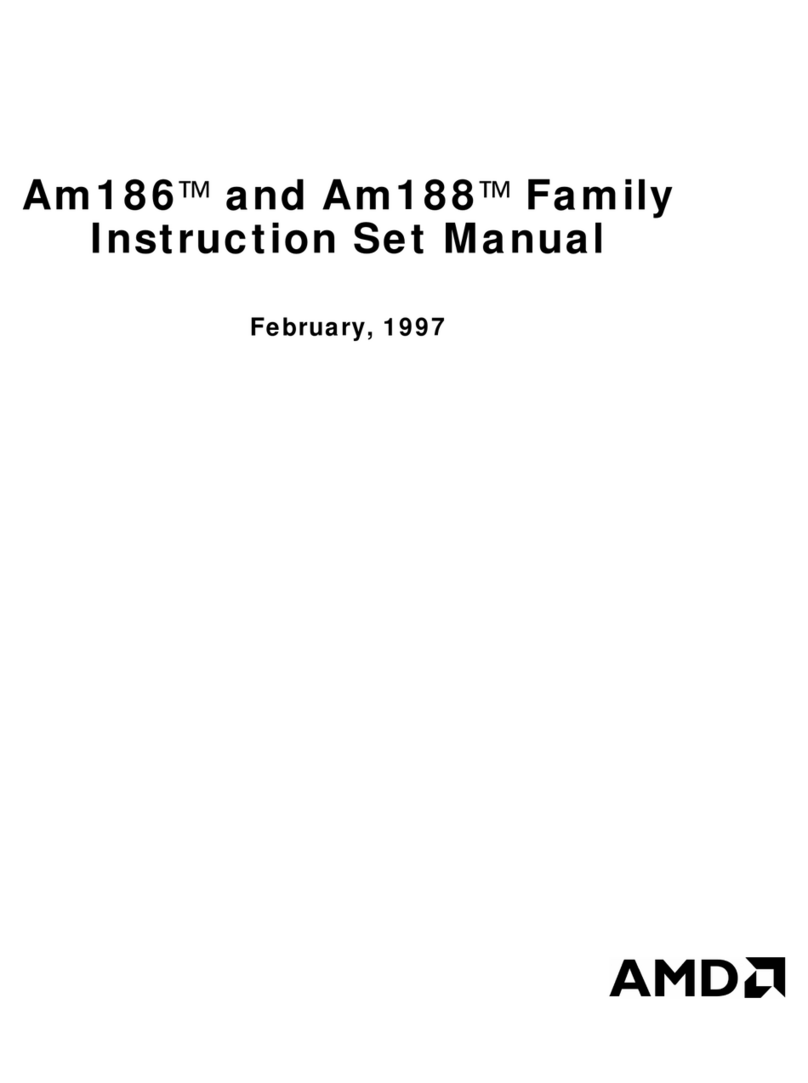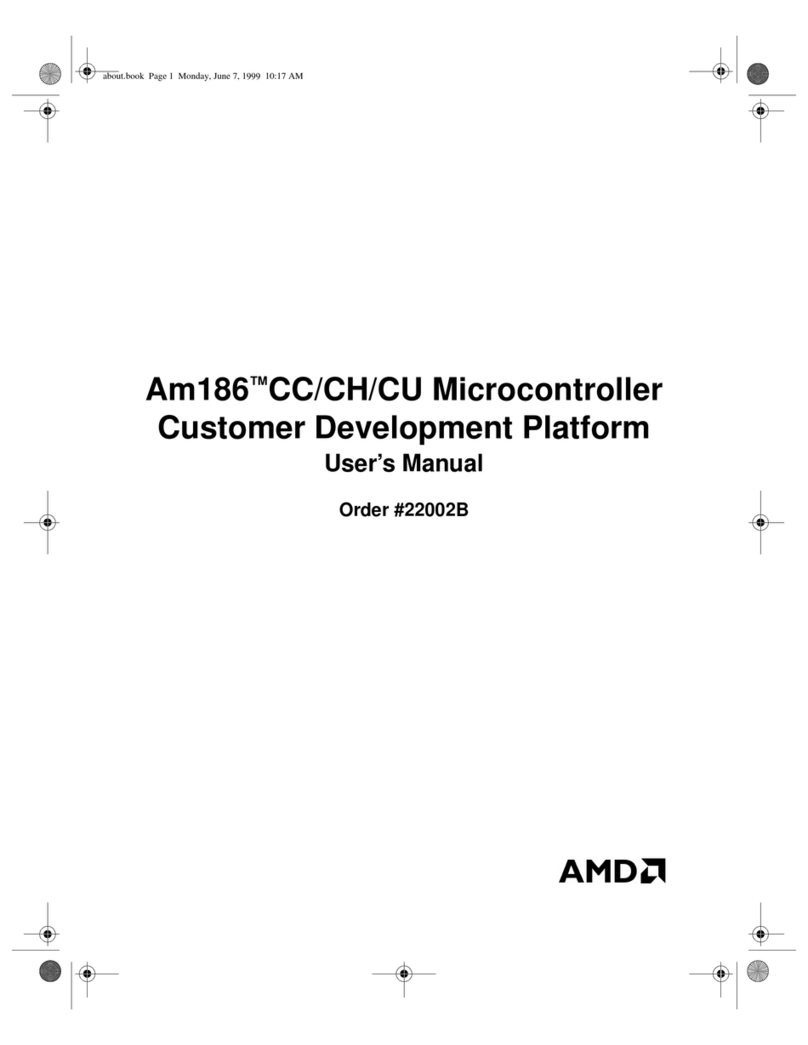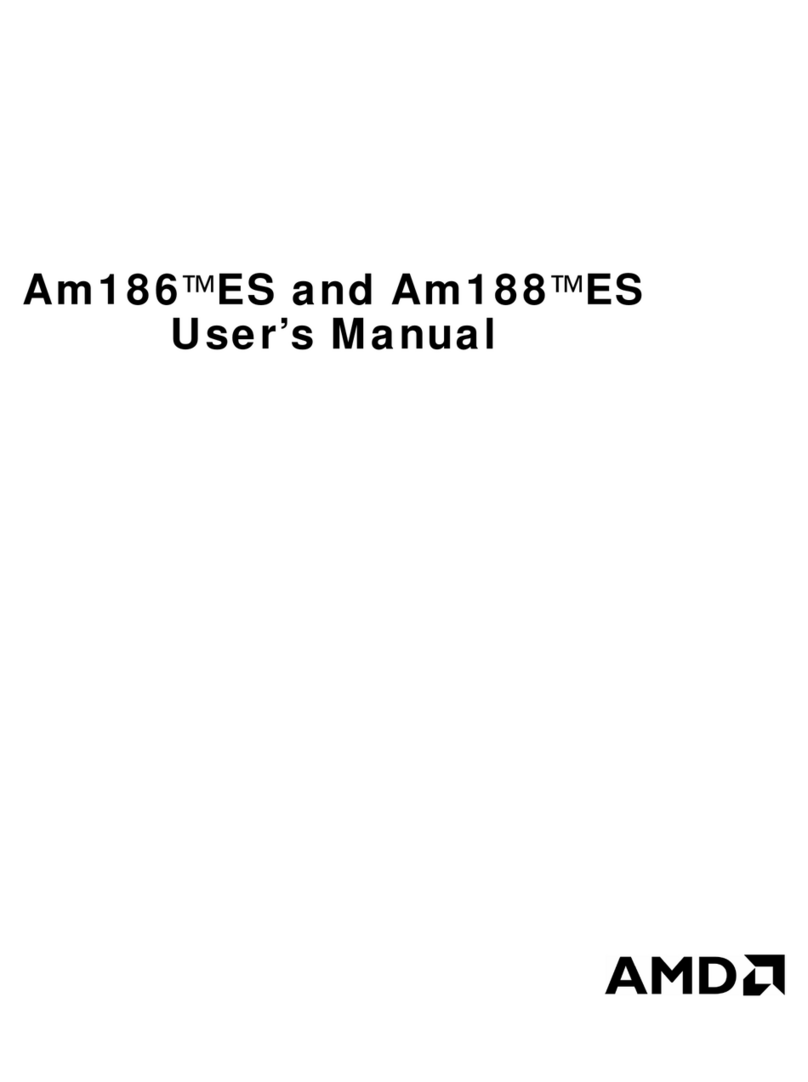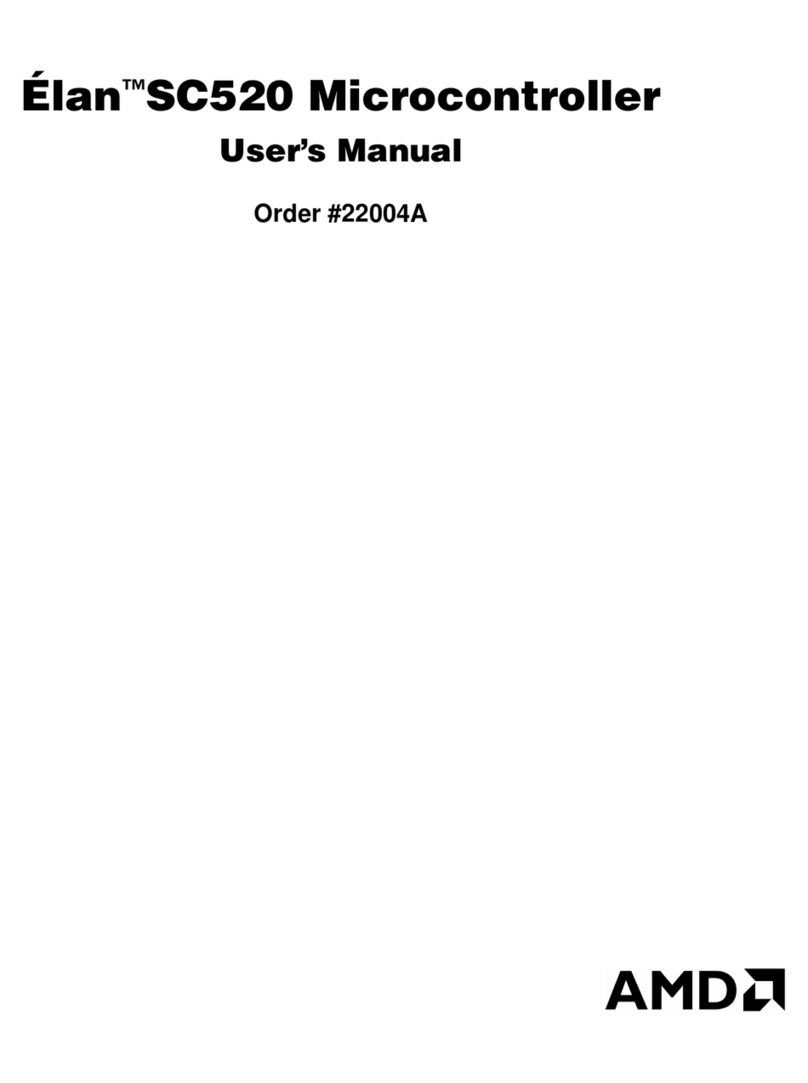
Table of Contents
vi Am186™CC/CH/CU Microcontrollers User’s Manual
2.7 Data Types. . . . . . . . . . . . . . . . . . . . . . . . . . . . . . . . . . . . . . . . . . . . . . . .2-8
2.8 Addressing Modes. . . . . . . . . . . . . . . . . . . . . . . . . . . . . . . . . . . . . . . . . .2-9
2.8.1 Register and Immediate Operands . . . . . . . . . . . . . . . . . . . . . .2-9
2.8.2 Memory Operands . . . . . . . . . . . . . . . . . . . . . . . . . . . . . . . . . . .2-9
CHAPTER 3 SYSTEM OVERVIEW 3-1
3.1 Overview . . . . . . . . . . . . . . . . . . . . . . . . . . . . . . . . . . . . . . . . . . . . . . . . .3-1
3.2 System Design. . . . . . . . . . . . . . . . . . . . . . . . . . . . . . . . . . . . . . . . . . . . .3-1
3.3 System Configuration . . . . . . . . . . . . . . . . . . . . . . . . . . . . . . . . . . . . . . .3-4
3.4 Initialization and Reset. . . . . . . . . . . . . . . . . . . . . . . . . . . . . . . . . . . . . . .3-5
3.5 Signal Descriptions . . . . . . . . . . . . . . . . . . . . . . . . . . . . . . . . . . . . . . . . .3-8
3.6 Bus Interface . . . . . . . . . . . . . . . . . . . . . . . . . . . . . . . . . . . . . . . . . . . . .3-28
3.6.1 Overview . . . . . . . . . . . . . . . . . . . . . . . . . . . . . . . . . . . . . . . . .3-28
3.6.2 Block Diagrams. . . . . . . . . . . . . . . . . . . . . . . . . . . . . . . . . . . . .3-29
3.6.3 Operation . . . . . . . . . . . . . . . . . . . . . . . . . . . . . . . . . . . . . . . . .3-30
3.6.3.1 Address and Data Buses . . . . . . . . . . . . . . . . . . . . .3-30
3.6.3.2 Programmable Bus Sizing . . . . . . . . . . . . . . . . . . . .3-30
3.6.3.3 Byte Write Enables. . . . . . . . . . . . . . . . . . . . . . . . . .3-31
3.6.3.4 Output Enable . . . . . . . . . . . . . . . . . . . . . . . . . . . . .3-31
3.6.3.5 Bus Mastering . . . . . . . . . . . . . . . . . . . . . . . . . . . . .3-31
3.6.3.6 DRAM Controller . . . . . . . . . . . . . . . . . . . . . . . . . . .3-32
3.7 Clock Control . . . . . . . . . . . . . . . . . . . . . . . . . . . . . . . . . . . . . . . . . . . . .3-32
3.7.1 Clock Features . . . . . . . . . . . . . . . . . . . . . . . . . . . . . . . . . . . . .3-32
3.7.2 PLL Bypass Mode. . . . . . . . . . . . . . . . . . . . . . . . . . . . . . . . . . .3-34
3.8 Hardware-Related Considerations. . . . . . . . . . . . . . . . . . . . . . . . . . . . .3-34
3.9 Comparison To Other Devices. . . . . . . . . . . . . . . . . . . . . . . . . . . . . . . .3-34
3.10 Initialization . . . . . . . . . . . . . . . . . . . . . . . . . . . . . . . . . . . . . . . . . . . . . .3-34
CHAPTER 4 EMULATOR SUPPORT 4-1
4.1 Overview . . . . . . . . . . . . . . . . . . . . . . . . . . . . . . . . . . . . . . . . . . . . . . . . .4-1
4.2 System Design. . . . . . . . . . . . . . . . . . . . . . . . . . . . . . . . . . . . . . . . . . . . .4-1
4.2.1 Multiplexed Pins . . . . . . . . . . . . . . . . . . . . . . . . . . . . . . . . . . . . .4-1
4.2.2 Emulator Connection . . . . . . . . . . . . . . . . . . . . . . . . . . . . . . . . .4-1
4.3 Operation. . . . . . . . . . . . . . . . . . . . . . . . . . . . . . . . . . . . . . . . . . . . . . . . .4-2
4.3.1 Usage . . . . . . . . . . . . . . . . . . . . . . . . . . . . . . . . . . . . . . . . . . . . .4-2
4.3.2 Emulator-Related Signals . . . . . . . . . . . . . . . . . . . . . . . . . . . . .4-2
4.3.2.1 A19–A0 . . . . . . . . . . . . . . . . . . . . . . . . . . . . . . . . . . .4-2
4.3.2.2 AD15–AD0. . . . . . . . . . . . . . . . . . . . . . . . . . . . . . . . .4-2
4.3.2.3 {ADEN} / BHE . . . . . . . . . . . . . . . . . . . . . . . . . . . . . .4-2
4.3.2.4 ALE . . . . . . . . . . . . . . . . . . . . . . . . . . . . . . . . . . . . . .4-3
4.3.2.5 ARDY and SRDY. . . . . . . . . . . . . . . . . . . . . . . . . . . .4-3
4.3.2.6 BHE . . . . . . . . . . . . . . . . . . . . . . . . . . . . . . . . . . . . . .4-3
4.3.2.7 BSIZE8. . . . . . . . . . . . . . . . . . . . . . . . . . . . . . . . . . . .4-3
4.3.2.8 [CAS1–CAS0] and [RAS1–RAS0] . . . . . . . . . . . . . .4-3
4.3.2.9 CLKOUT . . . . . . . . . . . . . . . . . . . . . . . . . . . . . . . . . .4-3
4.3.2.10 LCS . . . . . . . . . . . . . . . . . . . . . . . . . . . . . . . . . . . . . .4-3
4.3.2.11 MCS3–MCS0. . . . . . . . . . . . . . . . . . . . . . . . . . . . . . .4-4
4.3.2.12 {ONCE} . . . . . . . . . . . . . . . . . . . . . . . . . . . . . . . . . . .4-4
4.3.2.13 QS1–QS0. . . . . . . . . . . . . . . . . . . . . . . . . . . . . . . . . .4-4
4.3.2.14 [RAS1–RAS0] . . . . . . . . . . . . . . . . . . . . . . . . . . . . . .4-4
4.3.2.15 RD . . . . . . . . . . . . . . . . . . . . . . . . . . . . . . . . . . . . . . .4-4
4.3.2.16 RES . . . . . . . . . . . . . . . . . . . . . . . . . . . . . . . . . . . . . .4-4
4.3.2.17 RESOUT . . . . . . . . . . . . . . . . . . . . . . . . . . . . . . . . . .4-4
4.3.2.18 S2–S0 . . . . . . . . . . . . . . . . . . . . . . . . . . . . . . . . . . . .4-5
4.3.2.19 S6. . . . . . . . . . . . . . . . . . . . . . . . . . . . . . . . . . . . . . . .4-5
4.3.2.20 SRDY. . . . . . . . . . . . . . . . . . . . . . . . . . . . . . . . . . . . .4-5
4.3.2.21 UCS . . . . . . . . . . . . . . . . . . . . . . . . . . . . . . . . . . . . . .4-5
4.3.2.22 {UCSX8} and WLB. . . . . . . . . . . . . . . . . . . . . . . . . . .4-5
































